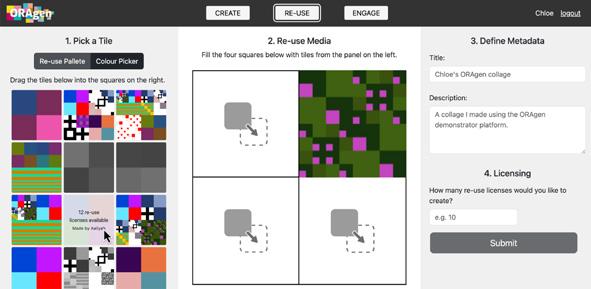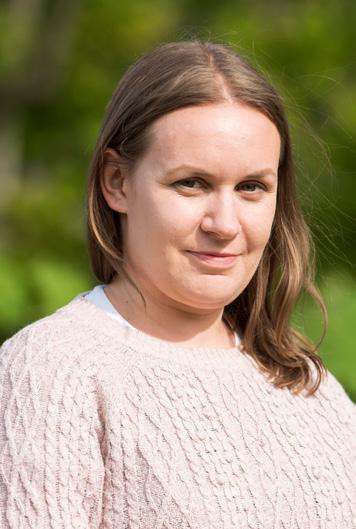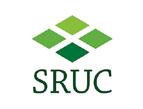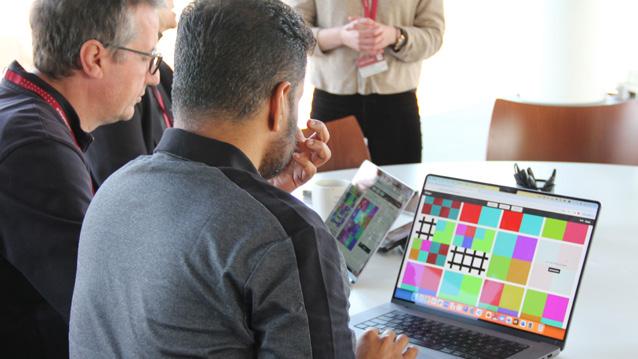








The Centre for the Decentralised Digital Economy (DECaDE) is a five-year National Research Centre part of the Centre for Vision, Speech and Signal Processing, exploring how emerging datacentric technologies, such as Distributed Ledger Technology (DLT) and Artificial Intelligence (AI), could transform our future digital economy through decentralised platforms.
DECaDE was launched in October 2020 by the University of Surrey, the University of Edinburgh and Digital Catapult. It is funded by £10million of support from industry (£6million) and from the UK Research & Innovation (UKRI) through the Digital Economy programme (£4million) – EPSRC grant reference EP/T022485/1.

Since DECaDE was founded three years ago, we have witnessed major societal events such as the global pandemic, the war in Ukraine and looking ahead, over two billion people will vote in public elections world-wide in 2024.
Cutting across all these events is the risk of fake news and misinformation; a risk exacerbated by the ease with which digital content can be created and shared. The inexorable progress in the power of creative tools, most recently generative Artificial Intelligence (AI), only serves to accelerate this risk further. It gives new urgency to DECaDE’s mission to shape the future digital economy model of work and value creation, ensuring a prosperous, safe and inclusive society for all.
We are proud of the impact DECaDE has made in contributing solutions to this major societal challenge, through the publication, commercial licensing, and open-source release of several media provenance technologies co-created with our industry partners. As one of the earliest members of the Adobe-led Content Authenticity Initiative DECaDE has influenced emerging standards in content provenance metadata and created impact both in creative products and broader thought leadership in the media provenance space.
In only three short years, DECADE has also seen the rise and fall of non-fungible tokens (NFTs) - a way to represent digital artwork as tokens that can be bought and sold in a decentralized global market via Distributed Ledgers (or ‘Blockchain’). During the global pandemic these became popular as traditional, centralised, creative markets were closed. Through projects such as ‘A Token Gesture’ DECaDE led some of the earliest user studies of NFTs and their strengths and weakness, proposing several innovations to advance this technology to create new fairer forms of a decentralized market that give creatives better agency
over content re-use. This is an issue especially prominent today in the age of Generative AI where creatives need better control, and ways to enable recognition and rewards for the use of their data in AI via provenance technologies.
We are also proud of DECaDE’s impact to public policy through evidence submitted to several government consultations and presented at All Party Parliamentary Groups (APPGs). Notably DECaDE researchers have engaged on a joint project with the Cabinet Office and HMRC exploring Reduced Friction International Trade (RFIT) to help shape policy in the 2025 UK Border Strategy. DECaDE continues to explore provenance enhancing tools such as NFT and Distributed Ledgers to push this work forward with our public sector partners.
Stepping back from these verticals, DECaDE is fundamentally about supply chains – be it the integrity and trust in media content, or electronic bills of lading for shipped goods or even of physical foodstuffs such as chocolate. In investigating these patterns, and solutions for supply chain, DECaDE is excited to create further impact in our increasingly decentralised digital economy.

Prof. John Collomosse DECaDE Centre Director

Prof. John Collomosse DECaDE Director & Principal Investigator

Prof. Steve Schneider Co-Investigator







Prof. Glenn Parry Co-Investigator

Dr. Chris Elsden Co-Investigator

Prof. Burkhard Schafer Co-Investigator

Dr. Caterina Moruzzi Co-Investigator












DECaDE is a multidisciplinary centre uniting researchers across the fields of Artificial Intelligence, Distributed Systems, Cyber Security, Design Interaction, Business and Law.

























DECaDE’s mission is to create the tools and techniques that will shape the future digital economy model of work and value creation,
ensuring a prosperous, safe and inclusive society
DECaDE is the UKRI Digital Economy Next Stage Centre for the Decentralised Digital Economy.
Our Digital Economy is increasingly a peer-to-peer, gig economy in which anyone can be a producer or consumer of digital goods or services. In other words, the digital supply chain. For example, anyone could ride or drive an Uber, rent or lease an apartment on Airbnb, but these dynamic peer-to-peer interactions that underpin our economy and society all currently take place on centralised digital platforms, with centralised governance that is often opaque and operates in isolation of stakeholders.
The centre has studied the decentralised economy through the lens of the Creative Industries – among the earliest sectors to transition to a decentralised model of content creation and consumption - and where centralised content platforms such as Instagram, YouTube and TikTok continue to dominate. In this creative supply chain, the issues of media provenance, rights and authenticity are paramount. The World Economic Forum (WEF) annual risks report notes AI generated misinformation is the biggest short-term threat to the global economy. With the incredible advances in generative AI, now more than ever people need tools
for all.
DECaDE explores how emerging data technologies such as Distributed Ledger Technology (DLT) and Artificial Intelligence (AI) could transform the digital economy through decentralised platforms to create fairer, more inclusive governance and value across the supply chain. A multidisciplinary approach is essential to this work. DECaDE comprises technologists, a business school, designers, a law school and cyber security centre across the universities of Surrey and Edinburgh, coupled also with the Digital Catapult’s DLT Field Labs to get our work out there and create impact in society. What are some of the impacts delivered by DECaDE’s uniquely multi-disciplinary approach to innovating decentralised platforms? We call out impacts from each of our three thematic areas of work.
to be able to make informed decisions about the authenticity of content.
DECaDE has contributed tools to trace provenance facts, such as who made an image and how to help users make those decisions. In other words, to ensure trust in the creative supply chain. These include working with our partner Adobe to develop image and video fingerprinting and watermarking technologies and influencing emerging international standards in provenance metadata (C2PA) and media tokenisation (JPEG NFT).
Our researchers have explored the tokenisation of media in the creative supply chain, and the opportunities
this raises for creatives to monetise their work – including in the era of generative AI when provenance offers new opportunities to recognise and reward contributions to AI training data, and new challenges to identify consent.
DECaDE has studied the rise of NonFungible Token (NFT) marketplaces during the global pandemic and the challenges these present around inclusion and on-boarding of users across varying digital literacy levels. The team are working on further evolutions of this experience to study media tokenisation in the creative industries against the backdrop of advances in Generative AI.

DECaDE continues its translational research agenda embarking now on a third thematic area around the future of work. The role of identity and reputation in the decentralised workplace is studied, for creating value, for example through connections to find employment within the creative industries.
The centre looks at ways to recognise contributions to voluntary work through tokenised mechanisms and will develop ways to discover data (for example search for images and NFTs) on decentralised systems to extract value through greater data fluidity without comprising on data privacy.
The team will explore how Distributed Ledger Technology (DLT) can help AI model trainers collaborate on model training, extracting value from privately held data without compromising on privacy. This will require new advances in self-sovereign identity, in federated learning and in the understanding of the design space and of value creation in the future decentralised workplace.
The centre examines the application of decentralised technologies in support of physical supply chains and business ecosystems. From creating frictionless trade across borders and influencing Government Policy to finding innovative ways to bridge the digital-physical divide when tracking physical supply chains, we look towards governmental advocacy and commercial initiatives to create practical impact.
The disparate nature of the global supply chain, with upstream suppliers often unknown to downstream customers, means there is often no single centralised trusted authority and a lack of visibility which can lead to problems. This aligns well with Distributed Ledger Technology (DLT) that seeks to establish trusted data with provenance, without reliance upon any single trusted authority.
Documentation can be vague, amended or lost and human rights abuses and environmental damage can be covered up. DECaDE has studied the use of DLT in supply chain for physical goods as diverse as tin, coffee and chocolate and in cross-border trade through the leadership role its researchers have played in the Reduced Friction International Trade (RFIT) project with the UK Cabinet Office.
As a translational research centre, DECaDE has abstracted key insights into the role of technologies across all these supply chain manifestations – from physical assets to born digital assets like images, videos and AI training data to enable trust and visibility in supply chains.

3 PATENTS JOINTLY FILED
56 PAPERS PUBLISHED
7 POLICY ENGAGEMENTS
2020
35
COMMERCIAL PARTNERS
5 ACADEMIC AWARDS AND RECOGNITIONS £583k
ADDITIONAL FUNDING SECURED
79 ENGAGEMENT ACTIVITIES
January DECaDE Centre founded.
February RFIT project is higlighted in the LawTech report on Smarter Contracts.
March
First DECaDE Field Lab on Privacy Preserving Image Sharing.
October
The Ecosystem of Trust evaluation report published.
November
DECaDE paper on video fingerprinting wins best paper prize at CVMP.
March
Token gesture, a public NFT experience ran in Edinburgh.
March
Report published on trust findings from the RFIT project.
April
Evidence given to APPG Blockchain on Government, Democracy and Voting.
November
Three patents on fingerprinting and watermarking licensed to commercial partner.
January
Series of four UK Cabinet Office workshops on Digital Borders run by DECaDE.
June
EKILA paper published proposing the ORA framework for media tokenisation and rights.
November
DECORAIT paper on AI training opt-out wins the CVMP best paper prize.
November
Open Source Release of TrustMark, a watermarking technology for media provenance.
January
Blockchain and Beyond paper published on Interaction Design for Blockchain.
March
DECaDE inputs to three public consultations on tokenised assets and digital identity.
October
ORAgen media tokenisation prototype developed.
January
DECaDE runs Creative Industries Workshop exploring media rights and tokenisation.
February RFIT higlighted in LawTech report on Smarter Contracts.
March
DECaDE presents at Lord Holmes’ Round Table on Blockchain for the Public Good, at the House of Lords.
May
Paper published by IEEE on Three Pillars of Provenance summarising work between DECaDE and the Content Authenticity Initiative.
December
Evidence given to APPG Blockchain on Blockchain in Government.
January
Supply Chain Management journal paper published on outcomes of the RFIT project.
February
Case study on supply chain provenance for conflict minerals published.
April
Paper published on the outcomes of the Token Gesture study.

Fake news and misinformation are major societal challenges. Provenance facts, such as who made an image and how, can provide valuable context for users to make trust decisions about visual content. Against a backdrop of huge advances in Generative AI in 2024, over two billion people will vote in public elections in countries representing 60% of global GDP, including Britain, the US, India and in the EU. DECaDE researchers have worked closely with the Adobe led Content Authenticity Initiative to develop provenance enhancing technologies and influenced the emerging C2PA technical standard for media provenance. Both contributions promise to play a key role in fighting fake news and the spread of misinformation.
Digital forensics offer one solution to visual misinformation, through tools to detect synthetic or manipulated content. However, misinformation and manipulation only partially intersect. Visual content frequently undergoes some manipulation for editorial purposes. Moreover, most misinformation does not involve manipulation but rather comprises unaltered images, used out of context, to tell a different story. Thus, forensics may uncover only a subset of misinformation and is engaged in a cat and mouse game with the ever-quickening progress of Generative AI.
Tools that explain the provenance of visual media, rather than decide its authenticity, help to put consumers in a more informed position to make trust decisions on visual content. A user encountering a photograph on social media, may be presented with information on who took it, when, and how it was modified. This additional context -- likened to a `digital nutrition label’ – can help the user decide on their level of trust in the content.
“DECaDE’s
research collaboration with Adobe and the Content Authenticity Initiative has helped accelerate the pace of innovation in media provenance technology. We’re excited to continue work together on authenticity and value creation as we bring the creative economy of the future to life.”
Andy Parsons, Sr. Dir. Content Authenticity Initiative, Adobe.
DECaDE researchers have contributed to the Coalition for Content Provenance and Authenticity (C2PA), a crossindustry standards group for media provenance. By developing solutions to mitigate a key weakness of metadata; that it is easily stripped from its assets including by all social media sites, the team have combined AI and Distributed Ledger Technology to solve this problem.
Working with our commercial partners, our academic research has translated into patents and has been used in products protecting users against misinformation. In collaboration with the Adobe-led Content Authenticity Initiative, DECaDE has developed content fingerprinting and invisible watermarking algorithms to help match content stripped of its metadata to a trusted repository, for example on the Polygon blockchain.
DECaDE co-developed the TrustMark watermarking technology with Adobe which has been open sourced under an MIT licence enabling commercial
use, to help drive adoption. Emerging legislation including the EU AI act, and the UK’s policy work on mitigating online harms calls out the importance of provenance technologies. The same technologies can be used to trace where the data our AI is trained on has come from, so that we know it will be safe. That is, safeguarding the data supply chains that will underpin our future digital platforms.
TEAM: Alex Black, Tu Bui, John Collomosse.
For DLT-based systems and services to become truly impactful and more widely adopted, and to ensure responsible and equitable development, a far wider range of people and organisations need to be engaged in their design, critique, and application in real-world contexts. However, like many emerging technologies, DLTs are complex and over-hyped. Their disruptive potential can enable new socio-technical imaginaries, but equally can obscure real-world implications and challenges.
DECaDE has developed numerous bespoke methods, workshops, experiences, and artefacts to engage new audiences in research on decentralised digital economies. Though these have been extensively published in academic contexts, there is more we can do to demystify how DLTs work and how they can provide value and make these approaches more widely accessible, available and adaptable. This ongoing work will produce a ‘playbook’ of methods and tools to enable co-creation around these technologies. Our ambition is hence to develop an accessible set of resources to guide more inclusive, thoughtful, and valuable development of decentralised technologies.
TEAM: Frances Liddell, Chris Elsden, Ella Tallyn.
DECaDE has explored understanding of the characteristics (emotional work and symbolic work) of the leading misinformation discourse on social media – such as X or Facebook.
The centre examined a historical case of the anti-vaccine fake news campaign targeting the human papillomavirus (HPV) vaccine in Ireland and the Irish Health Service Executive’s (HSE) response. Research explored the period between 2014 and 2019 when the anti-vaccination group REGRET employed a fake news campaign to reduce the HPV vaccination rates to 40% in only two years. The HSE launched a counter campaign challenging REGRET’s argument through logical and factual information, but their strategy had little impact on vaccination uptake. Subsequently, Laura Brennan, a 25-year-old Irish woman suffering from terminal cervical cancer caused by
HPV, became a patient-advocate and the public face of its HPV campaigns. She used social media to share her personal experiences through pictures and videos, often showing the impact of the illness on her body. Her compelling story improved vaccination rates to 74%.
We define the impact of fake news as a legitimacy crisis (the so called ‘Liar’s Dividend’). Our findings reveal how repairing organisational legitimacy is enabled by the creation of an emotional connection with the target audience, an approach we call emotion work strategies. Laura’s use of images of her body shows the importance of material objects, and more concretely the body, in discursive strategies of legitimation.
TEAM: Itziar Castello, Marie Joachim, Glenn Parry.
ORAgen is a demonstrator built by DECaDE to probe public understanding and reception to the concepts of media tokenisation and rights. By allowing users to create, tokenise, license and remix simple colour collages, the web application demonstrates the technologies underlying the ORA framework. This framework enables creators and end-users to independently prove ownership of their digital assets and associated licenses; embed metadata including provenance data in a way that cannot be easily stripped or taken away; and design and issue specific and bespoke licenses for their digital creations.


Through this interactive demonstrator, DECaDE has engaged a range of individuals and organisations in conversations about how ORA could apply to their work as an attribution and rights management tool. Primary research included an exploratory interview study which took place from November 2023 – January 2024 with professionals from the cultural sector including museum professionals, curators and artists working in the art and technology field. Through the Digital Catapult, a workshop was organised to engage over 30 creative industries stakeholders to map out the challenges and opportunities of the ORA framework in their organisations.
Kar
Alexander (Alex) Black is a final year PhD student in the Centre for the Decentralised Digital Economy (DECaDE). Alex joined DECaDE in October 2021, and has recently submitted his thesis on media provenance. His work on video fingerprinting won a best paper prize at CVMP 2022 and his further work on the topic VADER was presented at ICCV 2023. His work on image fingerprinting, published at the CVPR Workshop on Media Forensics in 2021, was among the first visual matching technologies to trace and compare images to establish their provenance helping to fight fake news and misinformation. Alex’s recent work uses Large Language Models to help explain visual inconsistencies using natural language and was published at AAAI 2024.
“When I joined DECaDE, I was excited to do work that has an immediate positive impact on the digital world. DECaDe has given me the opportunity to work on projects involving both images and video, as well as natural language, which has been a great novel experience. I am grateful for the support and guidance I have received from my supervisors and colleagues.”

Provenance also has a role to play beyond authenticity, to enhance creative attribution. The need for artists to be recognised and rewarded for the re-use of their intellectual property is fundamental to the creative economy. This issue is particularly acute with the emergence of Generative AI. The provenance of synthetic media is the GenAI model that created it, and, in turn, the training data used to create that model. Legislation is now emerging in the US, EU and UK requiring clearer signalling of synthetic media provenance on the grounds of transparency. Going further, a solid basis for establishing provenance for generative content, may unlock new opportunities for value creation in the creative economy, such as auditing the re-use of images in GenAI training data to compensate contributing artists.
DECaDE has developed the EKILA system to explore this new compensation model with its commercial partners. EKILA helps
trace the training images most responsible for a Generative AI image, it then uses Non-Fungible Tokens (NFT) to trace the owner of those responsible images. NFTs represent images as digital tokens that can be bought and sold on a DLT. They came to prominence during the global pandemic, which limited traditional monetisation routes for digital artists. EKILA extends NFTs to help creatives assert usage rights over their images, and as a mechanism for issuing micropayments for different uses, including GenAI training. We refer to this extension as ORA (Ownership-Rights-Attribution). ORA was also referenced in a further standardisation submission to the JPEG NFT group, which DECaDE formed in collaboration with the UCL Centre for Blockchain.
TEAM: Kar Balan, Andrew Gilbert, John Collomosse.

How can digital art be ‘owned’?
Scan the QR code to view the project.
A Token Gesture, was an exhibition and research project to introduce, explore and critique new public interactions and ownership of digital art via ‘non-fungible tokens’ – more commonly known as NFTs. Presented in March 2022, shortly after the NFTboom in 2021, it sought to critically engage with the implications of NFTs for creators and public audiences beyond an online crypto-bubble.
Working with two Scottish generative artists, a street-level interactive system was created which enabled members of the public to generate a unique piece of digital art simply by presenting a colour to a fixed camera. Participants were then carefully guided through setting up a crypto wallet to claim and mint an NFT — a unique, digital token - representing their piece of artwork which could not be transferred, or exchanged. However, it served to register the artwork, evidence an individual’s contribution, and could allow them to control if their artwork is displayed on the City Screen projectors.
Our findings from surveys and interviews of those who took part demonstrated how the absence of any economic value for the token, made the artwork and Token Gesture NFT meaningful in ways that extended beyond its immediate (limited) utility and offered participants something through which to construct their identities. The research also explored contemporary challenges of owning digital things, and the extent to which NFTs, and ‘Web3’ technologies offer meaningful records and forms of ownership for end-users.
TEAM: Martin Disley, Evan Morgan, Ella Tallyn, Chris Elsden.

Exploring how biomarkers can link cocoa products to the digital world, creating supply chain visibility.
An immutable ledger of biomarkers can be created using blockchain to provide a trusted source of provenance.
Multinational chocolate firm executives admit the cocoa supply chain is “broken”. Factors such as high demand and volatile prices create incentives for fraud and environmental and labour abuses. An estimated two million child labourers work on cocoa farms in West Africa.
This is not a new problem. The human misery caused by chocolate supply has been documented for more than 100 years. Ivory Coast’s government prevents firms directly approaching farmers to create projects that rewards good practice. A key perpetuating factor is the difficulty of tracing cocoa and its derivative products back to specific farms. Cocoa is frequently grown on small remote farms and local traders aggregate crops to create commercially viable quantities and increase quality.
As crops are mixed so early in the supply chain, tracing beans back to origin becomes extremely difficult. Our previous research has highlighted the difficulty of linking the physical and digital worlds in food supply (Rogerson and Parry, 2020). This work employed biomarkers, a ‘biochemical bar code’ created from DNA extracted from cocoa plants. These provide unique identifiers for plants that also appear in their cocoa beans and survive industrial processing. The work demonstrated an individual farm’s beans can be identified in a retail chocolate bar made from a mixture of beans of different origins. We envision the next stage is a distributed ledger providing provenance for a database allowing individuals to trace chocolate bought anywhere in the world. Such technology will allow companies to evidence good practice, corroborated against sciencebased audits.
TEAM: Pedro Lafargue, Mike Rogerson, Glenn Parry.
DECaDE explores applications of decentralised technologies to supply chain visibility that co-creates value for individuals, organisations and society.
We live in a highly interconnected world, with global supply chains forming the backbone of international trade. With an increasingly complex and fragile interconnected network of supply chains, the ability to monitor inter-organizational activities has become progressively more difficult through a lack of visibility and with no single centralised trusted authority. Our projects focus on how Blockchain-based solutions can provide common trusted data to improve supply chain efficiency and trust.
DECaDE examined how a blockchain system was used to help meet mandatory supply chain transparency (SCT) regulations.
USA and EU have created legislation targeting conflict area minerals, the “3TG” metals: tin, tantalum, tungsten and gold. A requirement of all firms in the world’s largest trading bloc, is to trace materials upstream in supply chains to show provenance. A solution to this challenge lies in the application of blockchain technology.
DECaDE’s recent study examines the efficacy of a blockchain system in addressing information uncertainties inherent in ensuring regulatory compliance within interorganizational networks (IONs). The ION studied, deployed a blockchain system created by provider firm Minespider,
with Minsur, a Peruvian tin mining company, and the multinationals Cisco, Google and Volkswagen who use tin solder in final products.
Findings indicate that a blockchain system can foster equality among network participants, facilitate compliance, and improve operational efficiency within an ION. By mitigating information uncertainties, blockchain promotes collaboration and data sharing while safeguarding sensitive commercial information. Notably, its decentralised nature prevents dominance by larger entities, providing a transparent record of mineral provenance and regulatory compliance. Cost analysis reveals that
Paradoxes describe the situation where multiple tensions create contradictory phenomena, appearing rational in isolation but illogical together. Often presented as binary, in practice paradox theory requires greater nuance and subtlety. Drawing on blockchain for supply chain experts we are examining the paradoxical tensions that surround blockchain. Experts identified a number of paradoxes, some of which are latent (i.e. unrealized) and others salient (i.e. experienced/realized) tensions in the DLT context.
Paradoxes discussed include the (im) mutability of a DLT system. According to the General Data Protection Regulation (GDPR), individuals have the right
to the erasure of their personal data from a system. However, DLT data are permanent and transparent, conflicting with GDPR. As an expert noted “How can you be forgotten from an immutable data store?” Another paradox identified arises from the tension between centralization and decentralization, also described as a collaboration / control paradox. Blockchain systems cannot prioritize collaboration entirely at the cost of control. Rather, both collaboration and control are required; meaning developers and partners must embrace the intractable tension and find a practical solution.
We advance knowledge and debates on paradox theory in management
blockchain system is economically viable. Challenges remain in acquiring comprehensive human rights data to ensure compliance with due diligence regulations.
The research underscores blockchain’s potential to address key environmental challenges, paving the way for enhanced transparency and regulatory compliance in supply chains.
TEAM: Alisha Tuladhar, Michael Rogerson, Juliette Engelhart, Birgit Altrichter and Glenn Parry.
studies, exploring its boundaries, characteristics, and the nature of paradoxes within the novel context of distributed ledger technologies (DLTs). For industry, we identify the managerial challenges related to the nature of paradoxes, and show how recognition of them improves effectiveness in system design and management.
TEAM: Birgit Altrichter, Mike Rogerson, Maria Laura Di Domenico, Glenn Parry.
“How can you be forgotten from an immutable data store?”

Blockchain technology is used to address traditional supply chain management problems, such as the lack of data transparency, advanced trust mechanisms and traceability.
However, in 2023 90% of blockchainbased supply chain initiatives were said to be suffering ‘blockchain fatigue’, driven by recent failures of large-scale projects such as those between Walmart Inc. and its suppliers and a joint IBM/Maersk shipping platform. The team undertook a series of projects to understand the challenges of blockchain adoption and conducted a systematic review to capture knowledge of blockchain applications in supply chains.
The research identified 34 success factors of blockchain adoption and proposes a multi-theoretical framework to explain those factors. For example, when organizations focus on applying blockchain technology to address changes in the business environment, they should have a clear vision, skilled employees, and the ability to change traditional business processes. The work facilitates and enables blockchain technology adoption, helping supply chain practitioners shape strategy.
A mixed-method approach applying integrate qualitive data coding with quantitative data analysis was used to analyse enablers or barriers to blockchain adoption. The work identified 29 common themes and employed statistical analysis to align themes
to technological (T), organisational (O), and environmental (E) dimensions. The work classified the themes as enablers, barriers or ambiguous to technology adoption. Most enablers to adoption were interdependent with other factors whilst barriers were discrete. More barriers than enablers were identified in literature. The most prominent themes, capability and compatibility, were mainly discussed as barriers to adoption.
This research ranks identified success factors and captures insights from practice into blockchain technology capability. Work will develop strategies to assist firms in appropriately implementing blockchain technology.
TEAM: Xiaotian Xie, Ying Zhang, Mahdi Tavalaei, Mike Brookbanks, Glenn Parry.
Birgit Altrichter is a Lecturer at Surrey Business School. She joined the EPSRC Centre for Decentralised Digital Economy (DECaDE) as a Research Fellow and subsequently transitioned to a Lecturer position at Surrey Business School. Birgit’s research focuses on business models in the decentralised digital economy. In collaboration with Prof. Glenn Parry and Prof. Maria Laura Di Domenico, she is exploring paradoxical tensions that emerge within distributed technology applications and more specifically, the control-collaboration paradox of blockchain implementation in supply chains. She presented findings at conferences (e.g., CADE in Venice) and to experts working in international trade technology development and adoption for the UK Government.
“I joined DECaDE during the final stages of my PhD in marketing and since then have transitioned to a Lecturer position at Surrey Business School. DECaDE allows me to continue working with academic, industry, and government experts across disciplines. I thoroughly enjoy the opportunity to continue my research in the decentralised digital economy, appreciate to learn from the centre’s colleagues, whilst also contributing to DECaDE’s work streams.”

Dr. Birgit Altrichter Lecturer at Surrey Business School

“Proud that our ground-breaking work on the RFIT project, supported by DECaDE researchers, demonstrated the use of innovative technologies in reducing friction in international trade and was included in the UK Government Border Strategy.”
The Lord Holmes of Richmond MBE.
Through DECaDE’s support of the Reduced Friction in International Trade programme (RFIT), a blockchain based proof of concept platform emulating the wine supply chain, we explored how physical supply chain use for Distributed Ledger Technology (DLT), can provide a common trusted data set, reducing errors and improving data visibility.
Mike Brookbanks has led the RFIT programme as prime researcher since April 2019. It is a cross-government, Industry and academic collaboration that developed a DLT/blockchain-based platform using technology from Chainvine Ltd. The permission-based system allows users to enter data as goods move through the supply chain, creating a trusted data source that meets UK Government requirements. Access to the data platform enables UK Government agencies to manage goods at borders proactively and increases efficiency and effectiveness. Work with the UK Government and Industry extended to the Ecosystem of Trust (EoT) pilot programme, exploring how systems can change the trust relationships between supply chain participants and improve operational efficiency. Mike Brookbanks acted as an advisor across the programme, with Atta Addo and Glenn Parry working within a pilot team. The objective of the EoT programme was to achieve ‘frictionless’ trade, building on the RFIT project to test if technological capabilities, real-time data and trusted relationships could reduce trade frictions without compromising the UK’s security or biosecurity. Between October 2022 and March 2023, six consortia pilot activities were undertaken by industry groups in partnership with the UK government.
Going forward, Carla Bonina has joined the team to support our research into how the governance of UK cross-border trade will unfold and adapt in the context of recent developments in UK policy and border digital platforms. As UK Government seeks a globally leading position in border policy through its UK Border Strategy, three areas are identified;
• The Ecosystem of Trust (EoT) will develop further.
• The UK Electronic Trade Documents Bill is new legislation helping the UK transition from traditional paper-based documents to digital formats. ETDB provides opportunities for innovation in global trade practices to achieve efficiency, security and resilience.
• A Single Trade Window (STW) system is being developed that will allow firms to submit information to a single agency rather than multiple country-specific applications for import and export. The research will draw on industry and government sources to capture perceptions of the current implementations and understand the evolution of ’sociotechnical’ governance, capturing the multiple facets of people and processes, governance of technology, and governance through technology.
Identity is at the foundation of the gig economy, underpinning platforms that enable freelancers and independent contractors to offer services, manage the work they take on, and grow their reputations. Recourse to centralised points of authority within such platforms, such as government backed identity or third-party identity providers, runs counter to the autonomy and independence offered by decentralised platforms. DECaDE has been investigating the role of digital identity schemes in the future decentralised digital economy.
With self-sovereign identity (SSI), individuals are not dependent on any third-party platforms to manage their
identity, but instead have control of their own identity and associated credentials. They obtain credentials issued by trusted organisations, such that their use of such credentials is entirely under their own control without any further involvement of the issuer. They can manage which aspects of those credentials to disclose while keeping other information private, underpinning trust in the profiles they publish.
DECaDE is prototyping decentralised technologies that aims to give subjects agency over managing their reputation across their portfolio of work and the ability to port their credentials from one platform to another. Individuals will be
Ashley Fraser joined the EPSRC Centre for the Decentralised Digital Economy (DECaDE) as a research fellow in cyber security in 2021. Her research focuses on decentralised digital identity management models, specifically, self-sovereign identity (SSI) systems. Ashley’s research focuses on the security and privacy properties of SSI systems. During her time as a research fellow in DECaDE she has developed security models for, and analysed the security of protocols that are implemented in SSI systems.
“Since joining DECaDE I have enjoyed the challenge of applying my knowledge of cyber security to novel and emerging decentralised technology. As an interdisciplinary research centre, DECaDE offers the opportunity to explore research directions beyond the purely technical – in particular, working with industry and public sector partners to investigate the requirements of SSI systems, distinguishing such systems from other digital identity management models.”
able to maintain and aggregate records including qualifications and testimonials from multiple sources including professional bodies, past employers, clients, customers and collaborators. Building upon earlier work within DECaDE exploring self-sovereign identity for photojournalism, this project broadens the scope to explore general technical solutions in the space of self-sovereign identity to ground identity from the physical to the digital without recourse to centralised authorities. For example, to enable digital twins representing physical identities or physical goods in decentralised platforms.
TEAM: Ashley Fraser, Steve Schneider.

The need for better regulation of the decentralised digital economy has now been recognised by legislators in the UK and Europe alike. Often running alongside similar initiatives to regulate AI, the last three years have seen a plethora of government consultations, white papers and legislative proposals.
DECaDE submitted responses on consultations by the Law Commission of England and Wales on ownership of digital assets, and the legal treatment of Decentralised Autonomous Organisation’s (DAO), and to the UK Government consultation on Consultation on draft legislation to support identity verification decentralised ID management to access. Where possible, we aimed to act as a conduit between our industry partners and the legislators, organising online workshops on the consultation on ownership of digital assets that introduced and explained the proposed legal changes to our partners, and eliciting their views to inform our responses. Our submission to the consultation on the ownership of digital assets was quoted in the Law Commissions response, taking on board in particular our view that any legislative
reform should not close the doors prematurely on ownership regimes for in-game digital assets. While broadly supporting the proposal, we also argued that any legislative reform should not accidentally privilege technological solutions that are particularly environmentally harmful over functionally equivalent approaches. Instead, we emphasised the advantages for the digital economy that a more flexible and less prescriptive approach to competing design solutions might bring, and the benefits that could come from incentivising a more experimental approach to the design and legal recognition of a new class of “ownership technologies”.
The draft Bill that the Law Commission has now put out for further consultations is consistent with our recommendations and addresses many of the concerns that we raised. It asks also for the creation of a new expert panel of regulators, industry and academics to further guide the legal development. This is an exciting development, and we are looking forward to working closely with any such body should the government implement the recommendations of the Law Commission
RESPONSE COORDINATOR: Burkhard Schafer.
While professional photographers are keen to be associated with their work, other users such as citizen journalists or activists might want to create and publicise pictures while still protecting their identity, for example to protect their personal safety or professional status.
DECaDE explores the use of self-sovereign identity (SSI) in enabling individuals to share images in a way that enables them to remain anonymous but protects their rights over the content. SSI will give individuals the opportunity to manage credentials around individual photos so that they are in control of what information they expose and to whom. Importantly SSI enables verification of credentials without the need to reveal the identity of the wallet holder, through the use of Zero-Knowledge Proofs.
Through the project we have developed a proof-of-concept implementation using the Hyperledger Aries technology stack, for privacy-preserving image sharing developed as a new use-case for self-sovereign identity technology. In line with our decentralised approach it aims to achieve this without the need to rely on any third party organisations to broker the relationship between the producer and the consumer. This gives the content authors control over their privacy without the need to trust any external parties, while ensuring they can be recognised as the creator of their content.
Using the Hyperledger SSI technology stack, it demonstrates the feasibility of the technology and provides a basis for exploration of understanding, ease of use, and the wider embedding of the solution into image capture technology and image sharing platforms.
Scan to view a video about Privacy-preserving image sharing through selfsovereign identity

DECaDE collaborates with industry, government policy members and public sector end-users to co-create adventurous and exciting research to shape the evolution of the digital economy towards a new 21st-century model of work and value creation.
“It continues to be a privilege to Chair the Independent Advisory Board for the DECADE Programme. John and his team continue their valuable research , not just on the theoretical application of new digital technology to the way in which we contract , transact and interact, but exploring the wider issues associated with these new economic and societal paradigms – privacy, legitimacy and security.
Over the course of the last few years I have seen for myself how the programme continues to produce impressive results but also to have a significant and practical impact on both commercial and policy decision making. As the programme matures I expect this impact to grow and the benefits of the programmes work to flow into commerce, government and society as a whole.”
Nick Davies, Director of the Centre for Digital Trade and Innovation and Innovation Lead at HMRC






























If you are interested in working with DECaDE and our partners to co-create a project please get in touch for further details - decade@surrey.ac.uk




To understand DECaDE’s impact and stakeholder engagement in the real-world, we run Distributed Ledger Technology (DLT) Field Labs facilitated by Digital Catapult, focused on solving coordination challenges and fast-tracking research translation.
The Field Labs are a safe place for convening, educating, supporting, and guiding multiple industry challenge owners to work alongside innovators, academia and regulators to create practical DLT-based solutions. They overcome the difficulties faced for projects involving decentralised systems, where deployment beyond lab-based proof of concepts requires coordination and buy-in from multiple stakeholders simultaneously.
The first DLT Field Lab was a collaborative project between DECaDE and their partners. After engaging Sony, BBC, Consulting Hyperion, Evolution Equity, photographers and freelancers, we designed a self-sovereign identity (SSI) proof-of-concept system to support privacy-preserving image sharing. The system enables photographers to share images, assert their rights over images, and remain anonymous while doing so. It has several potential applications, for example, whistleblowers and activists who want to share images that expose wrongdoing or bring attention to a cause but fear repercussions if their identity is tied to the image.
SSI is a digital identity management system that enables users to control the management of their identity, by collecting credentials from issuers. Verifiable Credentials (VCs) play a crucial role within SSI, enabling digital assertions between issuers and holders without relying on centralised databases.
The use case explored during the Field Lab, centred on a photographer aiming to manage image rights without disclosing
their identity. Multiple stakeholders included Thoday and Cavendish, issuers of credentials for membership and image registration, and Franklin News, a news agency seeking to use images with verified ownership.
We used Hyperledger Aries which is an SSI toolkit that supports the minimal disclosure principle, which means that users can collect credentials and present identity proofs that need not reveal entire credentials, only the minimal data necessary to meet the purpose of the identity proof request. We designed a system in which the user can collect credentials regarding their registration with an organisation and then the image itself, and then prove that they have registered that image without revealing their identity.
The solution demonstrated that SSI technology can be used to achieve these goals and align the various interests of all stakeholders involved.

DECaDE is working to explore how ownership, rights and attribution data me be embedded into digital media files under a practice termed “tokenised media” to create an irrefutable source of information and enable machinereadable licenses. This framework, referred to as ORA, an attribution and rights management tool, can be demonstrated through an online tool, called ORA-gen to highlight the potential possibilities for “tokenised media”.
The focus of this Field Lab was to examine the ORA framework in the context of a solution for managing the rights of creators online. ORA-gen demonstrator combines the C2PA standard for embedding digital provenance data within visual media, non-fungible tokens for asset tracking on a blockchain, and smart contracting for managing the interactions between these two. The Field Lab was structured to help explore the potential value hypotheses we envisioned for industry adoption and challenge our preconceptions.
By hosting a Creative Industries Workshop with 30 participants from a broad range of creative backgrounds, real-world testing and feedback with the framework was enabled. All participants discussed the applications of tokenised media and how it could deliver more efficient digital licensing and digital asset management. Valuable insights were gained from industry professionals regarding recurring challenges and key concerns they face, particularly around GenAI and web scraping tools utilising their assets. The discussions highlighted the importance of protecting brand identity and exploring opportunities for tokenised rights to create new monetisation streams for digital creators.
“The Creative Industries Workshop sparked an insightful conversation, shifting the focus from debating the necessity of DLT, to exploring its practical applications for protecting digital assets.”
Industry workshop attendee
DECaDE’s pioneering work in tokenised media offers a promising solution, embedding ownership, rights, and attribution data directly into digital files. Through platforms like ORA-gen and the DLT Field Labs, we continue to navigate this evolving landscape. It’s clear that the integration of blockchain technology and tokenised media holds immense promise in protecting creators’ rights and fostering new avenues for monetisation in the digital era.
Responsible Innovation is integral to thinking about how distributed systems can empower the digital economy, considering how technologies affect individuals, society, and the environment. Conversations around distributed systems are often clouded by hype, fearmongering, jargon, and gatekeeping. There is often a lack of clarity and guidance around whether distributed systems may be appropriate and beneficial in particular contexts, and in what ways they may be developed and adopted to realise the potential benefits and mitigate harms.
To address this gap, the DECaDE team is working on a Responsible Distributed Systems Toolkit, which guides users throughout the early stages of a distributed systems project. The Toolkit identifies common challenges non-experts face in using and implementing distributed systems, and providing resources on the benefits, risks, and responsible development of distributed systems.
To increase the usability of the Toolkit for non-expert audiences, we follow five key principles; application over information, ethics and people come first, simplify complexity, always be guiding and providing variety. The toolkit will help to facilitate alignment between experts and adopters and increase accessibility and inclusivity of the ecosystem.
Dr. Frances Liddell joined DECaDE in September 2023 as a post-doctoral research associate in Design Informatics, University of Edinburgh. Together with Dr. Chris Elsden, she is leading the qualitative fieldwork for the ORAgen research project, an online demonstrator that explores how decentralising technologies might shape and address challenges on attribution, rights, and ownership in the digital creative economy.
In addition, she has been supporting the development and facilitation of the field lab workshop that took place in January 2024 with participants from the creative industries, led by Digital Catapult.
“Working on DECaDE has given me the opportunity to explore important issues on ownership, rights, and attribution, through digital prototypes and it has been a privilege to work with innovative tools and support these with my knowledge and expertise of the cultural and creative fields.”

Dr. Frances Liddell Research Associate

As our digital economy trends towards an increasingly decentralised model, DECaDE is well positioned to innovate new technologies and understandings to support new ways of working and creating value across digital supply chains.
The Cambridge Analytica data mining scandal in 2018 marked a pivotal moment for society’s awareness of the value, and the risks, of sharing personal data. The monetisation, without consent, of data, transformed public attitudes to freely contributing data to centralised platforms. As we enter the era of Generative Artificial Intelligence (AI) we see the cycle repeat, of questions raised over large-scale re-use of data and digital assets, this time for training AI models.
Questions over the provenance of data used to train AI models are now paramount. Where did the data come from? Who owns it and did they give consent? How should they be recognised or compensated for that use?
Today there is a universal recognition that data holds significant value that may be unlocked by improving data fluidity into and across platforms. But this capability requires robust provenance of data and digital assets. There cannot be a more critical moment to study decentralised technologies and to ensure equitable and inclusive governance of this digital supply chain.
I’m proud of the huge research momentum DECaDE has built in the data provenance space. We have created new tools to tokenise and monetise creative assets, whilst ensuring agency and consent. We have studied the business models, contributed to policy interventions, and studied public attitudes to technologies such as NonFungible Tokens (NFTs) underpinning these. We have built media provenance technologies and applied these through
the centre’s commercial partners, and open standards organisations, to help fight fake news and misinformation – one of the most urgent societal challenges of our time.
We have translated our understandings to the physical supply chain, partnering with government and industry to study ways to reduce friction in cross-border trade and exploitative practices such as modern-day slavery through improved provenance of commodities. Distributed ledger technology (DLT) was born out of the desire to create crypto currencies, yet it is fundamentally a general technology for ensuring data provenance. It is natural to apply DLT to supply chain provenance, and remarkable that the patterns that have emerged in its application translate so readily across so many forms of digital and physical supply chains.
Many open questions remain open –not least the digital twinning of identity and physical goods to DLT, the challenges of actor onboarding, the communication of trust across all digital literacy levels, and the scalability of the business models and technologies that underpin this decentralised future. The regulatory space is still catching up to the implications of decentralised governance and emerging issues in digital asset ownership and bills of lading.
DECaDE has two further years to run, and we are excited for the innovations we will continue to bring to the digital supply chain, and the next generation of inter-disciplinary researchers trained by DECaDE who will create the essential infrastructure for this our increasingly decentralised digital economy.
As a large multi-disciplinary centre, we are proud of our role in growing the UK’s capability in Digital Economy
research and have seen three of our postdoctoral researchers transition into faculty positions to further their research careers, and others graduate move into academia and industry. We wish them well and look forward to the next wave of innovations brought by the DECaDE centre as it explores the decentralised future of our digital economy.
Prof. John Collomosse,
DECaDE Director
Kar Balan is a final year PhD student with the EPSRC Centre for Decentralised Digital Economy (DECaDE). With a diverse background initially rooted in the film and animation industries, Kar has cultivated a blend of technical and creative skills. Now, Kar conducts research at the intersection of computer vision & blockchain technologies with a focus on digital content provenance.
His work addresses complex issues within the realms of copyright, privacy, and attribution in the Generative Al space. Kar is community-minded and enjoys research and creative problemsolving, wishing to leverage his technical abilities to build decentralised, accessible, and inclusive products that positively impact society.
“Working within DECaDE has created unique opportunities for me not typically available to PhD students. For example, we developed one of our publications into an interactive app as part of our Field Labs. This allowed us to engage with professionals in the creative and cultural industries, exploring the complexities of media tokenisation and its implications for ownership, rights, and attribution. DECaDE is a very interdisciplinary environment, which I truly enjoy - approaching research problems from a multitude of perspectives and disciplines drives innovation and amplifies the impact of our work. We are a cohesive team and I think a lot of us are united by the fact that decentralisation resonates with us on an ideological level. I especially appreciate the blend of research, industry, and policy within DECaDE, which offers multiple avenues for me to explore in my future career.”


Our latest research at the forefront of the decentralised digital economy
Decentralised Creative Economies and Transactional Creative Communities: New Value Discovery in the Performing Arts. Chris Elsden, Chris Speed, Dave Murray-Rust. Published in: Data-Driven Innovation in the Creative Industries (1st ed.) Terras, M., Jones, V., Osborne, N., & Speed, C. (Eds.). (2024). Routledge.
A Token Gesture: Non-Transferable NFTs, Digital Possessions and Ownership Design. Chris Elsden, Evan Morgan, Ella Tallyn, Suzanne R. Black, Martin Disley, Burkhard Schafer, Dave Murray-Rust, and Chris Speed. Published in ACM Hum.-Comput. Interact. 8, CSCW1, Article 25 (April 2024).
ORAgen: Exploring the Design of Attribution through Media Tokenisation. Frances Liddell, Ella Tallyn, Evan Morgan, Kar Balan, Martin Disley, Theodore Koterwas, Billy Dixon, Caterina Moruzzi, John Collomosse, and Chris Elsden. In Designing Interactive Systems Conference (DIS Companion ’24), July 1–5, 2024, IT University of Copenhagen, Denmark. ACM, New York, NY, USA. (2024).
The impact of Industry 4.0 technologies on the resilience of established cross border supply chains. Brookbanks, M., Parry, G., Published in Supply Chain Management: an International Journal (2024)
Blockchain for compliance: An information processing case study of mandatory supply chain transparency in conflict minerals sourcing. Tuladhar, A., Rogerson, M., Engelhart, J., Parry, G., Altrichter, B. Published in Supply Chain Management: an International Journal (2024)
Formalization memories: Towards a pattern approach to legal design. Leon Qiu, Yiwei Lu, Burkhard Schafer. Published in Jusletter IT (2024).
To Authenticity, and Beyond! Building Safe and Fair Generative AI upon the Three Pillars of Provenance. John Collomosse and Andy Parsons. Published in IEEE Computer Graphics and Applications (IEEE CG&A). 2024.
ProMark: Proactive Diffusion Watermarking for Causal Attribution. Vishal Asnani and John Collomosse and Tu Bui and Xiaoming Liu and Shruti Agarwal. Published in Computer Vision and Pattern Recognition (CVPR). 2024.
Towards End-to-End Verifiable Online Voting: Adding Verifiability to Established Voting Systems. Mohammed Alsadi; Matthew Casey; Constantin Catalin Dragan; François Dupressoir; Luke Riley; Muntadher Sallal; Steve Schneider; Helen Treharne; Joe Wadsworth; Phil Wright. Published in IEEE Transactions on Dependable and Secure Computing, October 2023
EKILA: Synthetic Media Provenance and Attribution for Generative Art. K. Balan and S. Agarwal and S. Jenni and A. Parsons and A. Gilbert and J. Collomosse. Published in Proc. CVPR Workshop on Media Forensics (CVPRW). 2023.
DECORAIT - DECentralized Opt-in/out Registry for AI Training. K. Balan and A. Black and S. Jenni and A. Gilbert and A. Parsons and J. Collomosse. Published in Conf. Visual Media Production (CVMP). 2023.
On the role of blockchain for self-sovereign identity. A. Fraser; S. Schneider. Published in Competitive Advantage in the Digital Economy (CADE 2022)
The impact of a blockchain platform on trust in established relationships: a case study of wine supply chains. Brookbanks, M., Parry, G. Published in Supply Chain Management: An International Journal, Vol. 27, No. 7, 128-146 (2022)
Blockchain and Beyond: Understanding Blockchains Through Prototypes and Public Engagement. Dave Murray-Rust, Chris Elsden, Bettina Nissen, Ella Tallyn, Larissa Pschetz, and Chris Speed. Published in ACM Trans. Comput.-Hum. Interact. 29, 5, Article 41 (October 2022).
The future of money as a design material. Speed, C., Rankin, J., Elsden, C., and Vines, J. (2022). Design Research Society Conference. DRS2022: Bilbao, 25 June - 3 July, Bilbao, Spain.
RepMix: Representation Mixing for Robust Attribution of Synthesized Images. T. Bui and N. Yu and J. Collomosse. In European Conference on Computer Vision (ECCV). 2022.
ARIA: Adversarially Robust Image Attribution for Content Provenance. M. Andriushchenko and Rebecca Li and Geoffrey Oxholm and Tommy Gittings and Tu Bui and Nicolas Flammarion and J. Collomosse. Published in CVPR Workshop on Media Forensics (WMF). 2022.
Broken chocolate: biomarkers as a method for delivering cocoa supply chain visibility. Rogerson, M., Lafargue, P., Parry, G., Allainguillaume, J. (2021) Published in Supply Chain Management: An International Journal, 27 (6), 728–741 (Jul 2021) Perspectives on ‘Good’ in Blockchain for Good. Parry, G., Collomosse, J. Published in Frontiers in Blockchain, 3 : Article 609136. (2021)
Deep Image Comparator: Learning to Visualize Editorial Change. A. Black and T. Bui and H. Jin and V. Swaminathan and J. Collomosse. Published in CVPR Workshop on Media Forensics (CVPRWS). 2021.
OSCAR-Net: Object-centric Scene Graph Attention for Image Attribution. E. Nguyen and T. Bui and V. Swaminathan and J. Collomosse. Published in Intl. Conf. Computer Vision (ICCV). 2021.
To see our full list of papers and for links visit decade.ac.uk
Please
decade.ac.uk
Centre for the Decentralised Digital Economy June 2024
DECaDE is a Digital Economy Next Stage Centre funded by the UKRI/EPSRC Digital Economy Programme under grant reference EP/T022485/1

